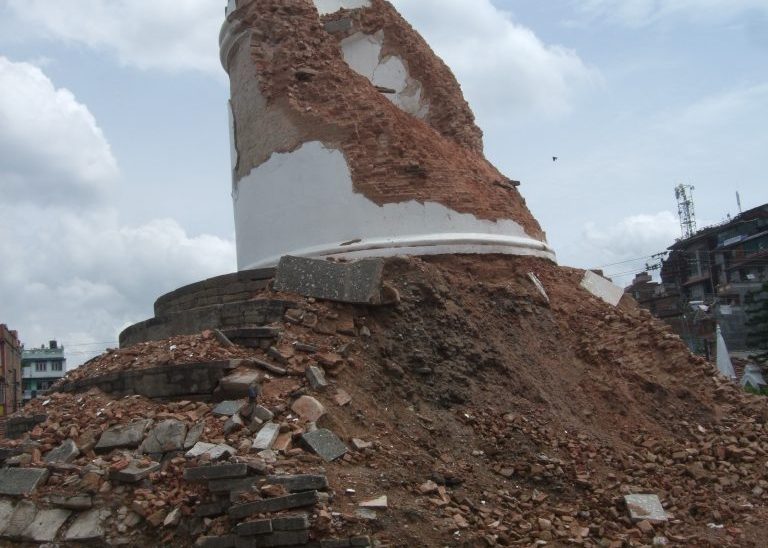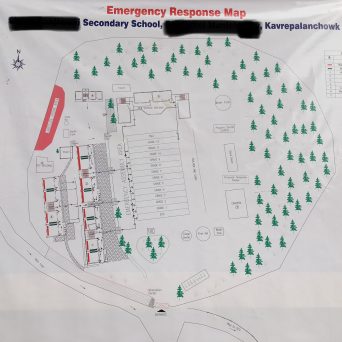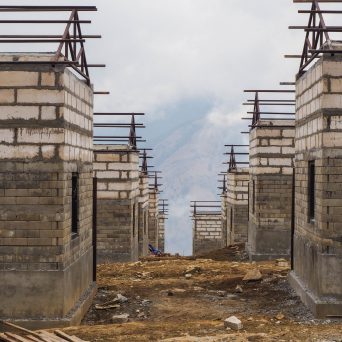
The Dharahara and the Nepali public, by Michael Hutt
Questions about public memory, history and identity often arise in the aftermath of a major natural disaster. When the earthquake that struck east-central districts of Nepal on 25 April 2015 destroyed the Dharahara, a 203-foot tower erected in Kathmandu nearly two hundred years ago, its ruined stump provided a focal point for many of them.
Although it was unloved by most cultural historians, in the immediate aftermath of the 2015 quake more Nepali media coverage was given to the collapse of the Dharahara than to the destruction of any other individual monument. The tower quickly became a symbol of national resilience and pride for a large section of the Nepali public.
The mukhtiyar General Bhimsen Thapa, who was the most powerful man in Nepal from 1806 to 1837, is credited with building one Dharahara in the grounds of his mansion, the Bagh Darbar. He probably also presided over the building of another at a nearby location, in the name of Queen Lalit Tripura Sundari. The towers are generally believed to have been modelled on Indian monuments such as the Qutb Minar in Delhi or the minarets of the Taj Mahal. During the 1833 earthquake one of them collapsed and was not rebuilt, while the other was only partially damaged and was quickly restored.
Neither Bhimsen nor any of his descendants explained the intended meaning and purpose of these towers, but this can be surmised from the historical context of their foundation. In 1816, the troops of the British East India Company had achieved victory over the army of Gorkha, the rapidly expanding hill kingdom whose Shah kings assembled the modern nation-state now known as Nepal. This military defeat marked the end of some 70 years of rapid Gorkhali expansion. In 1837 King Rajendra Bikram Shah described the surviving Dharhara as ‘a symbol of national independence, indivisibility, sovereignty, Gorkhali pride and progress’—an expression of defiance and nationalistic pride, right in the face of the British East India Company and its Resident in Kathmandu.
Once it had been restored, the surviving Dharahara remained intact until the next major earthquake struck Nepal in 1934. Its upper portion collapsed during this quake but by late 1936 it had been rebuilt once again, though to slightly reduced dimensions. In 2004/5 the management of the site was transferred to a private company, Sidewalkers Pvt Ltd, which allowed members of the public to climb its internal staircase to take in the panoramic view from the top for a fee. A small public garden, a café and a ticket office were established at the foot of the tower.


Dharahara, 1987 (above) and 2015 (below). Copyright Mike Hutt
The destruction of the Dharahara in 2015 inspired the composition of poetry, the publication of media-driven survivor stories, the creation of miniature replicas, the printing of T-shirts, the tattooing of bodies, the painting of murals, the posting of Youtube videos, and hundreds of postings on social media. Its reconstruction is a high priority for the government, which has vowed to use only domestic funds for the purpose.
The discourse generated by the destruction of the Dharahara should be understood against the backdrop of ongoing sociocultural and political contestations in Nepal: the rise of identity politics and federalism; the abolition of the monarchy; the establishment of a secular republican state; and the sudden promulgation of a new constitution in September 2015 after more than seven years of inconclusive debate and negotiation. The public mourning for the loss of this monument and its adoption as an icon of hope and resilience lent it particular potency for the hill nationalism and anti-Indian sentiment that swept through Nepal the following autumn.
In his book The Political Biography of an Earthquake, Edward Simpson has suggested that the aftermath of a disaster reveals what is most ‘dear’ to the public that survives it, and that this public is inevitably more aware of the ‘cultural battles’ of the aftermath than those who come to intervene (Simpson 2013: 96). However, in the introduction to their book Contested Histories in Public Space: Memory, Race, and Nation, Walkowitz and Knauer caution against the notion of a single ‘public’ in such a context. They argue that we should conceive of ‘multiple publics with divergent and often competing interests and different stakes in how histories are represented’ (2009:3).
So what were the boundaries and contours of the Nepali public that took the Dharhara to its heart as a symbol of both loss and pride? To borrow Simpson’s words again, to which Nepali public was the Dharhara ‘dear’? The dissonance between not only local and international perspectives on heritage and identity but also between differing perspectives on this matter within Nepali society itself will be a central concern of my research on this topic.
References
Simpson, Edward 2013. The Political Biography of an Earthquake. London: Hurst and Co.
Walkowitz, Daniel J. and Lisa Maya Knauer (eds) 2009. Contested Histories in Public Space: Memory, Race, and Nation. Durham and London: Duke University Press.



